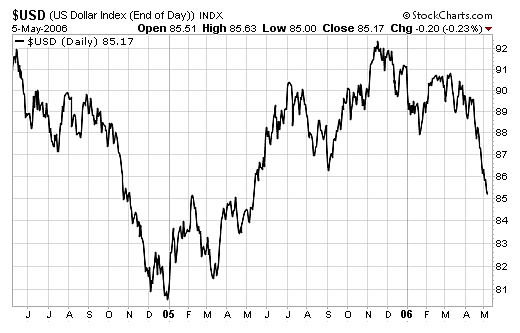| Home | About Us | Resources | Archive | Free Reports | Market Window |
The Second Most Famous Oil GeologistBy
Tuesday, May 9, 2006
Dr. M. King Hubbert may be the most famous oil geophysicist to have ever lived. In 1956, Hubbert predicted U.S. oil production would peak sometime between 1965 and 1970. At the time everyone laughed at him, but his prediction almost came true... U.S. oil production peaked in 1971. Hubbert became a folk-hero. I just got off a conference call with the world’s second most famous oil geologist. His name is Professor Kenneth Deffeyes... Deffeyes was born in the oil fields of Oklahoma during the Great Depression. He spent decades as an oilman with Shell and just retired from a full-time teaching position at Princeton. Now he spends his days lecturing investment bankers and brokers on peak oil. Deffeyes has traveled all over the world studying oil fields. He claims to be the only non-Saudi geologist ever to have studied the reservoir rock samples from Saudi Arabia’s Ghawar oil field. Ghawar is by far the largest conventional oil field in the world. In 2001, using the exact same techniques Hubbert used to predict peak U.S. oil production in the 1950s, Deffeyes predicted global peak oil production would occur on December 16, 2005. He made his prediction in 2001 in a book titled: Hubbert’s Peak: The Impending World Oil Shortage. “It turns out I was a few weeks off,” said Deffeyes in yesterday’s conference call,“With the benefit of the most recent data, we now know the actual peak occurred sometime in mid-January 2006.” If Deffeyes is correct, mankind has a serious problem: The world will never again produce as much crude oil as it did in January 2006. By 2010, Deffeyes thinks global oil production will be 10% below today’s levels. By 2035, oil production will be half. He says the main challenge to his view comes from the U.S. Geologic survey. They claim there are still huge untapped oil reserves in the USA. “I could give a fifty minute lecture on all the statistical flaws in the survey,”said Deffeyes. “The oil is not there.” Then moderator asked him about his price targets. “If we get really lucky,” he said, “if we get some very mild winters, and at the same time they stop blowing up pipelines in Iraq and peace breaks out in Iran and Nigeria... if all that happens at the same time, it wouldn’t be surprising to see oil fall back into the $30-$40 per barrel range.” “But that doesn’t mean the problem is over,” he added. He also mentioned that, on the upside, we could easily see oil go over $100 and stay there. Next, the moderator asked him what sectors he thinks will be most affected. The aviation industry was the first he cited. The commercial airlines, cargo airlines, manufacturers and suppliers all have a big problem: Unlike other energy consuming industries, there is no substitute for jet fuel. You can’t fly an airplane on ethanol or pig manure. Worldwide agriculture is also at risk. In winter, get accustomed to eating more locally grown vegetables - like turnips and rutabagas – as it becomes too expensive to fly fruits and vegetables in from the southern hemisphere. Food prices in general will increase. The “green revolution” that drastically lowered the cost of food in the 1970s, was built on three things: better seed varieties, mineral fertilizers, and pesticides. Pesticides and fertilizers are both extremely energy intensive to produce. As fuel prices rise, so does the price of fertilizers and pesticides, and in turn ... the price of food rises too. The third industry at risk is the rubber-tired automotive industry. Deffeyes joked that it’s a common saying that GM and Ford are enjoying their last swirls around the toilet. So we have to wonder... Is this all doomsday hype or the real deal? Here at DailyWealth, we’re not experts in oil geology... nor can we prove oil production has peaked. But it seems to us that high oil prices have had little impact on most Americans and Wall Street is still skeptical of peak oil. In which case... Higher oil prices are a good bet. Good Investing, Tom Dyson Market NotesTHE U.S. DOLLAR: A TRULY UGLY CHART In our April 20th edition, we presented an ugly chart of the U.S. dollar. As today’s look shows, the dollar’s chart is getting worse. The buck has plummeted in the past month, and we’re at fresh lows for the year. So what should a trader do when the dollar stages a relief rally? Dennis Gartman of The Gartman Letter has laid out his strategy: In other words, Gartman is short the dollar, and will use any rebound to get shorter. The greenback takes a beating (2-year chart):
-Brian Hunt |
Recent Articles
|


